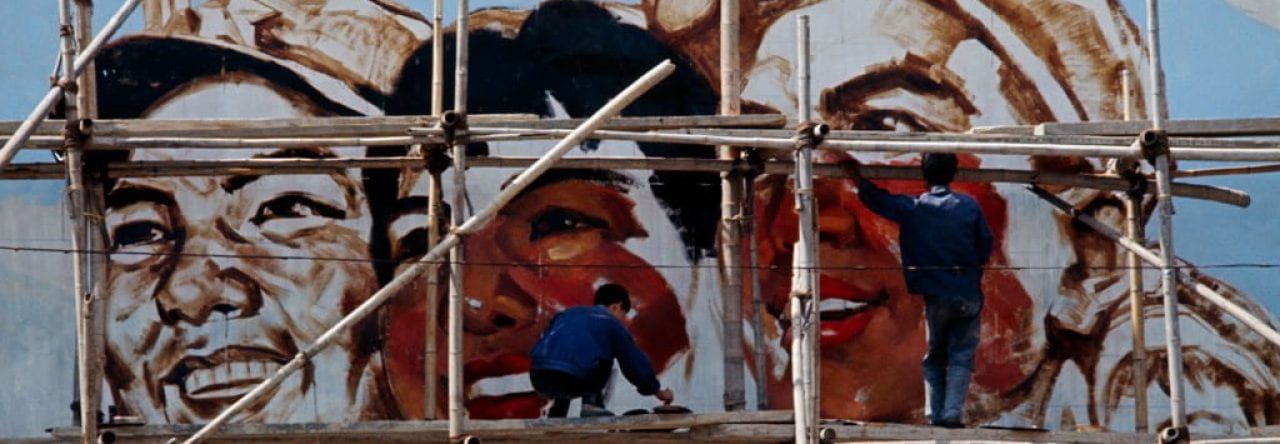Chen Qiulin was born in Sichuan, China in the 1970’s. She is significantly younger than some of the artists we are researching. This is key in understanding what she is trying to express in her artwork, as the focus of her work is focused closer to modern day China. This piece along with several others are focused on her feelings around the Three Gorges Dam. The Three Gorges Dam is the largest dam in the world and supplies the largest hydroelectric plant in the world (“Three Gorges Dam, China.” 2009). The Three Gorges Dam also assisted in preventing severe flooding in the villages and cities below it.
While this is an incredible accomplishment, it came at the cost of 1,300 villages being displaced and all nearby towns ending up under water. She explores her dilemma of feeling proud of a modern China while also feeling extreme remorse for her lost village. In this piece a female figure is dressed in a western style wedding dress standing in a forgotten, run down village.
The archway above her is meticulously carved with drawings of people and Chinese characters. An ancient piece of China’s history is surrounded by trash. This is shining a light on forgetting tradition and the effects that it can have. The effect being the female standing in a western style dress, she stands out like a sore thumb in her own country. Chen Quilin frequently plays with the idea of things left behind and uses forgotten material in her sculptures. It is clear this town is forgotten, although at first glance it is not obvious the bride is forgotten as well.
She is standing at the entryway of an old town, standing still, looking out. As if she is watching something, or someone. Her dress is still clean and brand new, suggesting her wedding just ended or never finished. There is no evidence in the picture as to why she is there, she could just be a symbol, the more likely option is she is a character standing in an old China representing some kind of departure. It could be between the old and the new or, a more simple answer, that she is watching her lover run from her.
Chen’s pieces are not supposed to make complete sense to the viewer, since her pieces are all “related to [her] memories” (Chen Qiulin. 2013). The most important thing to understand about this piece is the disconnect between the new China and the old China.
Bibliography:
Chen, Qiulin. 2009. 陈秋林 Old Archway. Photography. 1000 plateaus gallery. https://www.1000plateaus.org/artists/30-chen-qiulin/works/1561-chen-qiulin-old-archway-2009/.
Chen, Quilin. 2013. Review of CHEN QIULIN 陈秋林 Interview by Monica Merlin. Tate.org. https://www.tate.org.uk/research/research-centres/tate-research-centre-asia/women-artists-contemporary-china/chen-qiulin.
Hung, Wu, Jason McGrath, and Stephanie Smith. 2008. Displacement : The Three Gorges Dam and Contemporary Chinese Art. Chicago, Il: Smart Museum Of Art, University Of Chicago. 56-81.
“Three Gorges Dam, China.” 2009. Earthobservatory.nasa.gov. June 8, 2009. https://earthobservatory.nasa.gov/images/38879/three-gorges-dam-china#:~:text=The%20Three%20Gorges%20Dam%20on.



Sophia Rothberg
I found this post to be very thought-provoking. Chen’s artwork is very different from my artist (Pan Yuliang); however, I found some similarities and differences. Both of our artists are making statements on their experiences and feelings as women from China albeit during different lifetimes. Jupiter has pointed out how Chen uses the past to comment on modern-day China and how she immerses herself in her pieces. Such as how Chen wears a Western-style wedding dress while being surrounded by destroyed tradition. She does this to explain that while China is moving forward, it leaves behind tradition, and at times causes negative effects that should not be overlooked. Chen’s use of symbols of the past makes me think about how my artist uses symbols from the past. It also makes me wonder how much Pan uses symbols from the past to criticize tradition while respecting it. Pan’s paintings are mainly of unclothed women that represent freedom from tradition and the past, yet there are self-portraits of herself clothed in traditional garments. I am curious as to what made Pan go from one to the other and what was happening in her life to make these changes or comments.